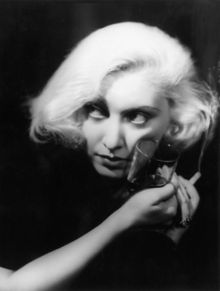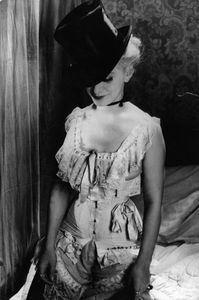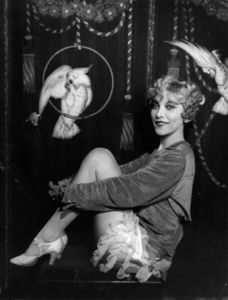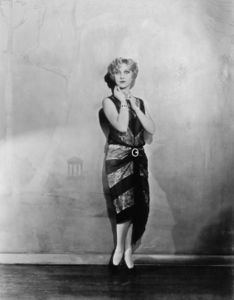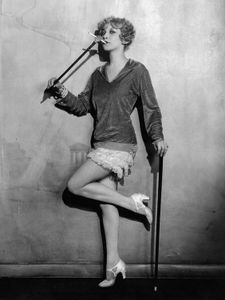Frances Day: Difference between revisions
(Created page with "{{Header| 04/24}}{{DEFAULTSORT:}} {{Infobox person | color = mistyrose | name = Frances Day |image = |birthname = Frances Victoria Schenk |birthdate = {{dob|1907|12|16}} |birthplace = East Orange, New Jersey, U.S. |deathdate = {{dod|1984|4|29|1907|12|16}} |deathplace = Windsor, Berkshire, England |deathcause = Chronic myeloid leukemia |occupation = Actress, singer |spouse = {{Marriage|Beaumont Alexander|1927|1938|end=divorced}} }} '''Fran...") |
No edit summary |
||
| Line 2: | Line 2: | ||
{{Infobox person | color = mistyrose | {{Infobox person | color = mistyrose | ||
| name = Frances Day | | name = Frances Day | ||
|image = | |image = FrancesDay-00.jpg | ||
|birthname = Frances Victoria Schenk | |birthname = Frances Victoria Schenk | ||
|birthdate = {{dob|1907|12|16}} | |birthdate = {{dob|1907|12|16}} | ||
| Line 16: | Line 16: | ||
Her career began as a nightclub cabaret singer in New York City and London. She made her London stage debut as a double act at the New Cross Empire with the dancer John Mills (later a distinguished actor), billed as "Mills and Day". This led to a chorus role in the 1929 West End production of ''The Five O'Clock Girl'' at the Hippodrome, London, which toured the provinces in 1930. She married Beaumont Alexander, an Australian agent and publicist in London, in 1927. He masterminded her early career as a dancer in West End nightclubs, where she created favorable notoriety by performing in a G-string with only an ostrich fan for cover. The couple divorced in 1938, and she never remarried. | Her career began as a nightclub cabaret singer in New York City and London. She made her London stage debut as a double act at the New Cross Empire with the dancer John Mills (later a distinguished actor), billed as "Mills and Day". This led to a chorus role in the 1929 West End production of ''The Five O'Clock Girl'' at the Hippodrome, London, which toured the provinces in 1930. She married Beaumont Alexander, an Australian agent and publicist in London, in 1927. He masterminded her early career as a dancer in West End nightclubs, where she created favorable notoriety by performing in a G-string with only an ostrich fan for cover. The couple divorced in 1938, and she never remarried. | ||
The following year, she found film stardom for her sexual performance as a notorious nightclub singer in Alexander Korda's movie ''The Girl From Maxim's''. Day was flagrantly bisexual, having affairs with [[Tallulah Bankhead]] and [[Marlene Dietrich]], and attracting the passionate admiration of Eleanor Roosevelt and George Bernard Shaw, who wrote one of his last plays for her, and was the mistress of the Prince of Wales (later King Edward VII), his brother Prince George, Lord Louis Mountbatten, Prince Bernhard of the Netherlands, Prince Bertil of Sweden, and Britain's Foreign Secretary and future British Prime Minister, Anthony Eden. She bought and refurbished Wayneflete's Tower in 1941, installing drainage and water, and a lift (to supplement the spiral staircase) found on a bombsite. | |||
<gallery mode="packed" heights="200px" caption=""> | <gallery mode="packed" heights="200px" caption=""> | ||
FrancesDay-1930s.jpg | file:FrancesDay-1930s.jpg | ||
file:FrancesDay-01.jpg | |||
file:FrancesDay-02.jpg | |||
file:FrancesDay-03.jpg | |||
</gallery> | </gallery> | ||
==Later years== | ==Later years== | ||
Revision as of 08:08, 1 May 2024
Frances Day (born Frances Victoria Schenk; December 16, 1907 - April 29, 1984) was an American actress and singer who became very popular in the UK in the 1930s.
Her career began as a nightclub cabaret singer in New York City and London. She made her London stage debut as a double act at the New Cross Empire with the dancer John Mills (later a distinguished actor), billed as "Mills and Day". This led to a chorus role in the 1929 West End production of The Five O'Clock Girl at the Hippodrome, London, which toured the provinces in 1930. She married Beaumont Alexander, an Australian agent and publicist in London, in 1927. He masterminded her early career as a dancer in West End nightclubs, where she created favorable notoriety by performing in a G-string with only an ostrich fan for cover. The couple divorced in 1938, and she never remarried.
The following year, she found film stardom for her sexual performance as a notorious nightclub singer in Alexander Korda's movie The Girl From Maxim's. Day was flagrantly bisexual, having affairs with Tallulah Bankhead and Marlene Dietrich, and attracting the passionate admiration of Eleanor Roosevelt and George Bernard Shaw, who wrote one of his last plays for her, and was the mistress of the Prince of Wales (later King Edward VII), his brother Prince George, Lord Louis Mountbatten, Prince Bernhard of the Netherlands, Prince Bertil of Sweden, and Britain's Foreign Secretary and future British Prime Minister, Anthony Eden. She bought and refurbished Wayneflete's Tower in 1941, installing drainage and water, and a lift (to supplement the spiral staircase) found on a bombsite.
Later years
She acted regularly in films until 1941, and appeared on the London stage in musical revues like Cole Porter's Black Vanities (1941, in which she sang with Bud Flanagan). In the 1950s she made only four films but found a new career as a regular panelist on the British version of What's My Line?', which ran from July 16, 1951, until May 13, 1963.
She was also a close "theatrical" friend of the Mayfair heiress Dorothy Hartman, owner of Lendrum & Hartman Limited, the major distributor of Buick and Cadillac cars in London. She was a regular guest at her country home – Stumblehole Farm, Dean Oak Lane, near Leigh, in Surrey
Death
She died of chronic myeloid leukemia, aged 76, in Windsor, Berkshire, after retreating into reclusion in Maidenhead when her career and public life ended. She left what remained of her estate to a young solicitor, Howard McBrien, in her handwritten will, which included the following directive:
[That] there be no notice or information of any kind of my death, except for and if a death certificate is obligatory. Any persons, private or Press, you shall simply say that I am no longer at this address. "Gone away. Destination unknown", and that is the truth.
External links
Chat rooms • What links here • Copyright info • Contact information • Category:Root
